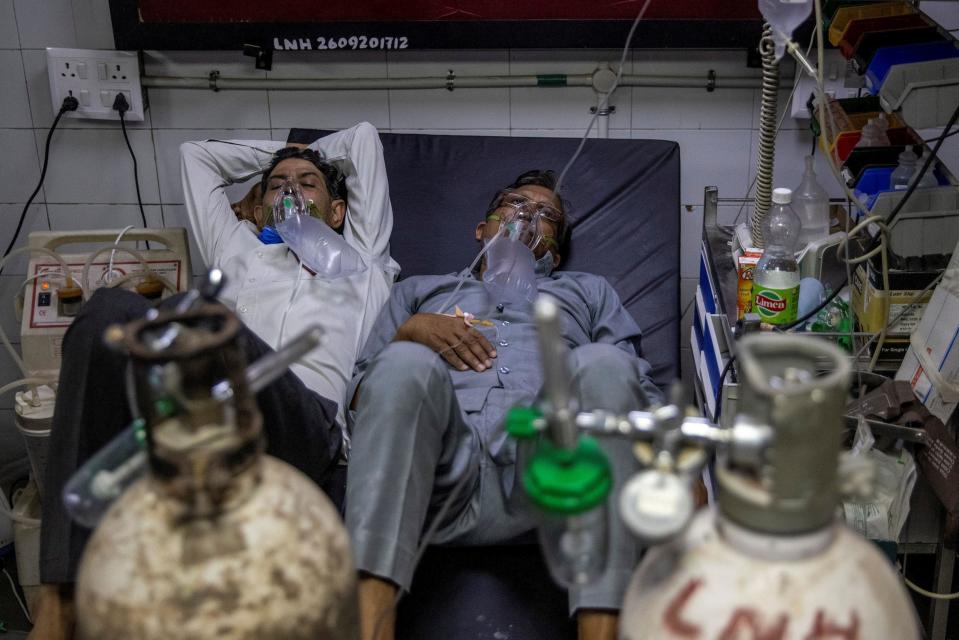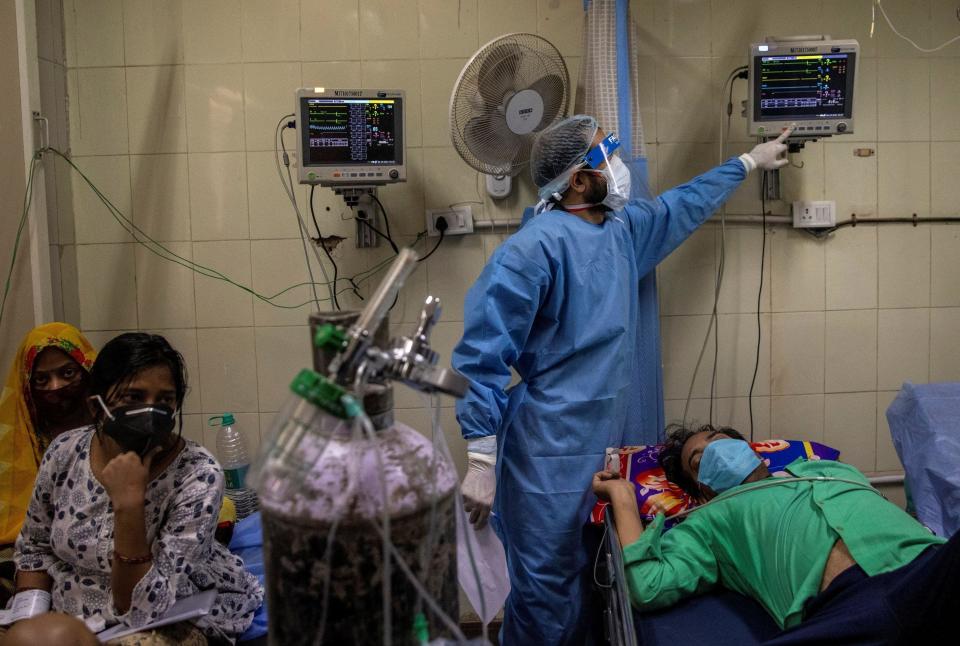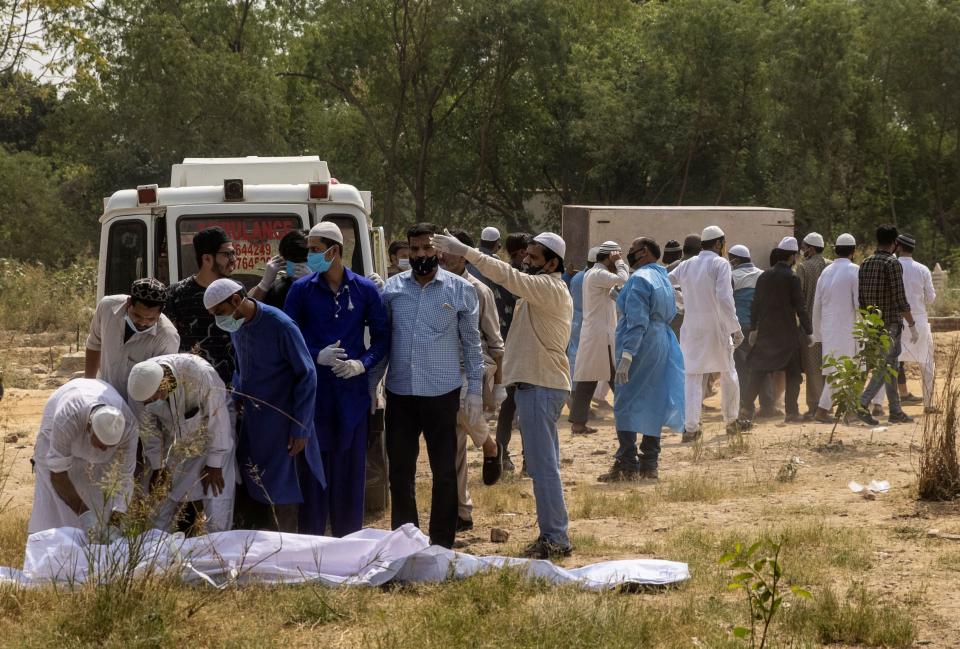India's COVID 2nd wave is a tsunami, and it's taking a grim toll

New Delhi — Most hospitals are full. In some cases, two patients share a bed. Stocks of oxygen, medicines and vaccines are all running out. Doctors and nurses are overworked. Thousands of patients are dying every day, leaving bodies to pile up outside crematoriums and graveyards. There's panic in the air as coronavirus cases multiply across India at the most fearsome rate since the pandemic struck more than a year ago.
India's second wave really started gaining steam this month, with the daily count of new infections repeatedly setting new records throughout April. The total number of COVID-19 cases reported in India now stands at over 15 million. More than 1.5 million of those infections have been reported in the last seven days alone. The daily average is now about 220,000 new cases — the fastest rate of COVID-19 spread in the world.
The second wave started in mid-March, and was underestimated on many levels: Many Indians had lowered their guard and stopped taking precautions, including wearing masks and maintaining social distancing; the government took several missteps, including allowing massive election campaign events and a huge religious gathering; even many experts predicted the second wave wouldn't be as bad as the first.

Over the winter, as many countries struggled with third waves of infections, the numbers in India were coming down. Some experts suggested India might not even see a second wave.
But it hit, and as of right now, government data show it to be about three-times worse than the first wave. With the pace of new infections still climbing, there's no indication yet that the top of this wave has even been reached.
Hospitals overwhelmed
Many doctors are calling this second wave a tsunami, and it's stretching India's already-lean healthcare infrastructure beyond its limits. Coronavirus patients often can't even find space to be admitted to a hospital. There simply aren't enough beds.
Maithili Badriprasad, 50, a healthcare practitioner, had to wait four days to get admitted to a hospital in Bengaluru, one of the top tech hubs in the world. She tested positive on April 5 and was recommended hospitalization as her condition worsened. But there were no beds. She was lucky to get an oxygen tank to use at home until April 9, when she was finally admitted to a local ward.
"There was no stretcher or wheelchair, I was asked to walk downstairs to get myself admitted. I was about to pass out," Badriprasad told CBS News.
She was discharged after a week of what she called a "shocking and unbelievable experience." Her lungs still haven't recovered fully.
"I told my daughter it's like a Jurassic world out there," Badriprasad said of the scenes she witnessed inside the strained hospital. "The doctors and nurses, who work like robots and get very little sleep in their PPE kits, get no time to listen to patients. They don't look at you, they look at your reports alone to make sure your COVID is treated… I am disillusioned with how things are happening without accountability."

"We waited two days for a hospital bed for my uncle," Manoj Bagle, a resident of Mumbai, told CBS News. "By the time he got one, his condition had deteriorated… he couldn't be saved."
Mumbai, home to Bollywood, is India's richest city, but its healthcare system is straining as new cases mushroom. Maharashtra, where Mumbai is located, is India's hardest-hit state with 35% of the country's total active cases.
The entire state has been put under lockdown until the end of April, with restrictions expected to get even stricter this week.
Double mutant strain
Some public health experts suspect a new, Indian-origin "double mutant" coronavirus variant — called B.1.617 — is behind the rapid spread of the disease in India.
"But we can't say that for sure at this stage; more analysis is needed," Dr. Prabhakaran Dorairaj, a senior cardiologist and Director of Centre for Control of Chronic Conditions at the Public Health Foundation of India (PHFI), told CBS News.
"It's affecting a lot of young people and children, too, and the symptoms are different from what we saw last year," said Dorairaj.
"This is a variant of interest we are following," Maria Van Kerkhove, the World Health Organization's technical lead officer on COVID-19, said on Friday. "Having two of these mutations, which have been seen in other variants around the world, is concerning."
The double mutant, which, like other variants that have emerged around the world, is suspected to be more infectious than the original strain of the disease, has now been discovered in at least 10 countries, including the U.S. and the U.K.
Drugs and oxygen running out
At least 11 of India's 29 states, including Maharashtra, Delhi, Uttar Pradesh, Gujarat, and Chhattisgarh, have notified the national government of shortages of hospital beds, medical oxygen and key drugs used to treat COVID-19, seeking immediate help.
Sonia Gandhi, leader of India's principal opposition party, the Indian National Congress, has accused Prime Minister Narendra Modi's government of "gross unpreparedness… in foreseeing, evaluating and managing the crisis."
Delhi's Chief Minister, Arvind Kejriwal, described the situation in his state as "very serious and worrisome," and said supplies of oxygen and the number of ICU beds were "decreasing very sharply."

Ramesh Verma, a senior government officer overseeing the coronavirus response at Delhi's Burari hospital, told CBS News they were facing an acute shortage of doctors and nurses, too.
Maharashtra state Chief Minister Uddhav Thackeray also phoned Modi's office last week to warn of oxygen shortages.
The federal government insists there are sufficient oxygen supplies, but it has ordered the construction of 162 new medical oxygen plants across the country. Indian media reports have said the government may be looking to import 50,000 metric tons of the life-saving gas.
Indian social media channels are filled with frantic appeals by people looking for help getting loved ones into hospitals, and for oxygen cylinders, plasma donations and the drug remdesivir. The medicine, shown to help people recover from COVID-19, started hitting the black market in India last year.
She passed away after helplessly waiting for medical care. 💔She went to LNJP, Hindu rao and then back to RML but oxygen bed couldn't be arranged. #COVID19India https://t.co/JqabKHrMkK
— Hemant Rajaura (@hemantrajora_) April 18, 2021
A doctor at one of Delhi's top hospitals, who didn't wish to be named, told CBS News the situation was "chaos all over."
"Anybody will tell you there is a shortage of beds, oxygen, and drugs," he said. "We have turned away some serious patients because we didn't have adequate ICU beds available… It's such a disgusting and helpless situation."
The doctor, who specializes in trauma and emergency medicine, said most of his colleagues are overworked, "some are not getting enough rest, or even time to eat properly."

"If this is the situation in India's biggest and the richest cities, you can imagine what would be happening in rural areas where there aren't even enough hospitals," Dr. Vikas Bajpai, an assistant professor at New Delhi's Jawaharlal Nehru University, told CBS News.
Last week, video emerged of COVID-19 victims' bodies lined up outside a government-run hospital in Chhattisgarh, highlighting the scale of the crisis in smaller states. Crematoriums and burial grounds in Gujarat, Uttar Pradesh, and Delhi are also overworked, with long queues of ambulances waiting their turn to deliver victims for funerals.
More than 178,000 people have died in India of the coronavirus.

Another 1,619 deaths were registered on Monday alone. Many of those dying are people who simply find it impossible to access treatment in time.
Vaccine supplies also low
India is running short of vaccines, too. Several states have told the federal government they're down to limited stocks.
India has administered more than 123 million doses of the two coronavirus vaccines currently being used: the Oxford-AstraZeneca vaccine, which is being produced domestically by the Serum Institute of India under the name of Covishield; and Covaxin, India's homegrown vaccine produced by Bharat Biotech. But only 14.3 million people have been fully vaccinated, which is just a little over 1% of the country's 1.32 billion population.
The government aims to have 250 million people vaccinated by the end of July, and from May 1 all adults will technically be eligible for a shot. Experts warn, however, that at the current rate of vaccination, India will fall short of its goal.
The government has approved the use of Russia's Sputnik V vaccine and opened doors to other major vaccines being administered around the world, including Moderna and Pfizer, but there are no supplies available yet.
Domestic shortages have also led to a severe strain on India's promised deliveries to the global COVAX initiative. The effort, backed by the U.N.'s World Health Organization, was launched to ensure poor and developing nations get their fair share of COVID-19 vaccines, but as India diverts stocks made by the Serum Institute (SII) for domestic use, about 64 lower-income nations have been left waiting for their deliveries.
"Delays in securing supplies of SII-produced COVID-19 vaccine doses are due to the increased demand for COVID-19 vaccines in India," the WHO said in a statement last month. "COVAX has notified all affected economies of potential delays," it said.
Last week, Adar Poonawalla, CEO of the SII, issued a public appeal to U.S. President Joe Biden to "lift the embargo of raw material exports out of the U.S. so that vaccine production can ramp up."
The Indian company is the world's largest maker of all vaccines, and it has delivered more than 100 million doses to India and exported around 60 million to other countries.
The Serum Institute has also requested a grant from India's government worth around $400 million to boost production of the AstraZeneca vaccine, and according to reports on Monday, Modi's government was expected to sign off on it.
Some of the hardest-hit states and cities are increasing restrictions to try to curb the spread of the virus, including new or expanded lockdowns in Delhi and Maharahstra, but even if vaccine production can ramp-up, many epidemiologists believe the number of cases will keep rising for about a month before the curve starts to dip.
"In the worst-case scenario, it may even take two months," said Dorairaj.
"How far the current wave goes really depends on individual COVID-compliance and restrictions of mass gatherings," Dr Ramanan Laxminarayan, founder and director of the Center for Disease Dynamics, Economics & Policy in Washington D.C., told CBS News. "Until then, we are in for a tough phase and it is difficult to predict how long the current situation will continue."
Eye Opener: Country waits for verdict in Chauvin trial

